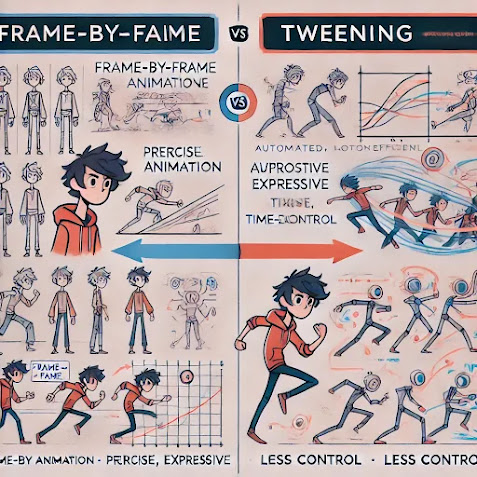Frame-by-Frame vs. Tweening: Which Animation Style Should You Use?
Introduction
Choosing the right animation style is one of the most important decisions an animator can make. Whether you're just starting out or refining your craft, understanding the differences between frame-by-frame animation and tweening can help you achieve the look and feel you want. Each method has its strengths and weaknesses, and the best choice depends on your goals, tools, and the type of animation you want to create.
What is Frame-by-Frame Animation?
Frame-by-frame animation, also known as traditional or hand-drawn animation, involves drawing each individual frame to create movement. This technique is used in classic 2D animation and gives animators full control over every motion, expression, and nuance of their characters. It is often used in Flipaclip, Adobe Animate, and traditional animation workflows.
Pros of Frame-by-Frame Animation:
High Control: Every detail is crafted exactly as you intend it.
Smooth, Organic Motion: Offers natural and expressive movement, great for character animation.
Artistic Freedom: Allows for exaggerated expressions and stylistic choices that automated techniques can't easily replicate.
Cons of Frame-by-Frame Animation:
Time-Consuming: Requires drawing each frame, making it labor-intensive.
Resource-Heavy: Takes up more time and effort, especially for longer animations.
Higher Skill Requirement: Requires strong drawing skills and an understanding of motion principles.
What is Tweening?
Tweening (short for "in-betweening") is an animation technique where keyframes are set, and the software automatically generates the frames in between. This method is commonly used in programs like Adobe Animate, Toon Boom Harmony, and Spine for game animation.
Pros of Tweening:
Faster Production: Automates the in-between frames, speeding up the animation process.
Less Drawing Required: Ideal for animators who prefer working with key poses rather than drawing every frame.
Smooth and Consistent Movements: Ensures fluid transitions between keyframes, perfect for motion graphics and rigged animations.
Cons of Tweening:
Less Organic Feel: Automated movement can sometimes look too mechanical.
Limited Artistic Control: Harder to achieve complex, hand-crafted expressions.
Software Dependent: Relies on specific tools and rigs, which may limit flexibility.
When to Use Each Animation Style
Choose Frame-by-Frame If:
You want highly expressive, hand-drawn animation.
You're working on character-driven animation with detailed movements.
You have the time and skills to animate manually.
Choose Tweening If:
You need to create animations quickly and efficiently.
You're making motion graphics, UI animations, or game assets.
You prefer working with rigs and keyframe-based motion.
Conclusion
Both frame-by-frame animation and tweening have their place in 2D animation. If you're aiming for fluid, expressive character animation, frame-by-frame is the way to go. If you're looking for efficiency and smooth motion with minimal effort, tweening is your best bet. The best approach often depends on your project and artistic goals, and many animators use a mix of both techniques to get the best results.
Which method do you prefer? Let us know in the comments below! Don’t forget to follow V-Star Animation for more animation tips and insights!



Comments
Post a Comment